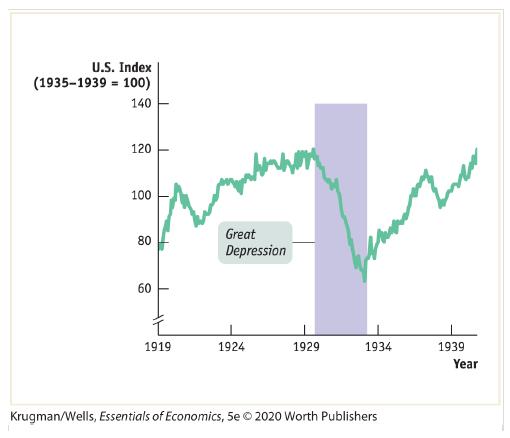Before there was the internet, there was mail order, and for rural and small-town America that meant,
Question:
Before there was the internet, there was mail order, and for rural and small-town America that meant, above all, the Montgomery Ward catalog. Starting in 1872, that catalog made it possible for families far from the big city to buy goods their local store wasn’t likely to stock
—everything from bicycles to pianos. In 1893 Sears, Roebuck and Co. introduced a competing catalog, and in the 1920s both companies opened physical stores around the country. The two firms struggled for dominance right up to World War II. After that, however, Montgomery Ward fell far behind. By 2001, it had closed all of its stores.
Why did Montgomery Ward falter? One key factor was that its management misjudged postwar prospects. The 1930s were a difficult time for retailers in general because of the catastrophic economic impact of the Great Depression. Figure 14-14 shows an index of department store sales, which plunged after 1930 and hadn’t fully recovered by 1940.
Montgomery Ward coped with this tough environment by cutting back: closing some stores, cutting costs, and accumulating a lot of cash. This strategy served the company well, restoring profitability and putting it in a very strong financial position.


Unfortunately for the company, it made the mistake of returning to this strategy after World War II—and the postwar environment was nothing like the environment of the 1930s. Overall department store sales surged: by 1960 they were more than four times their 1940 level.
Sears and other retailers expanded to meet this surge in demand, especially in the rapidly growing suburbs. But Montgomery Ward, expecting the 1930s to return, just sat on its cash;
it didn’t open any new stores until 1959. By failing to expand with the market, Montgomery Ward suffered what turned out to be an irretrievable loss of market share, reputation, and name recognition.
Nothing in business is forever. Eventually Sears too entered a long, slow decline. First it was overtaken by newer retailers like Walmart, whose big box stores didn’t sell large appliances but generally sold other goods more cheaply than Sears, in part by using information technology to hold costs down. More recently, the rise of online shopping has hurt traditional retailers of all kinds. But Montgomery Ward’s self-inflicted defeat in the years after World War II nonetheless shows how important it is for businesses to understand what is happening in the broader economic environment—that is, to take macroeconomics into account.
Questions:-
1. Why was it profitable for Montgomery Ward to close some of its stores during the Great Depression?
2. Use Figure 14-14 to compare the nature of the Great Depression to the Great Recession. What about the Great Depression made Montgomery Ward’s decision not to expand in the 1940s appear rational? Would the same decision be rational now, in the aftermath of the Great Recession? Explain.
Step by Step Answer:






